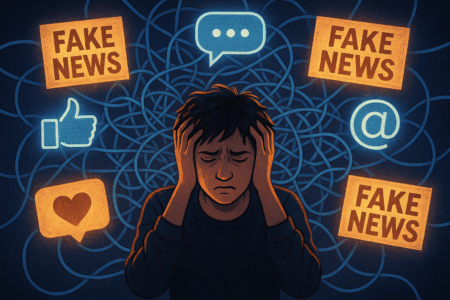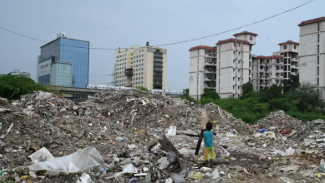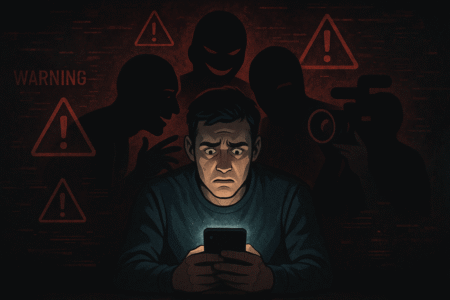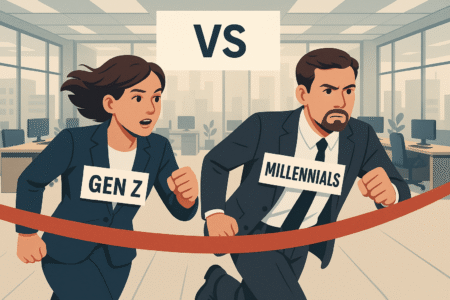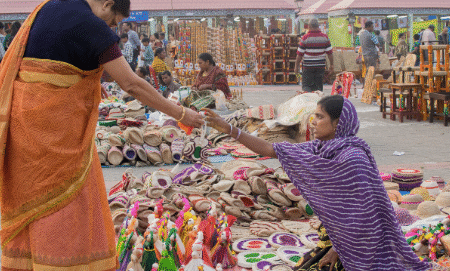The world of 2025 is one where opportunity and uncertainty collide. On one hand, humanity has never been more connected, technologically advanced, and resourceful. On the other, the World Economic Forum’s Global Risks Report 2025 warns of a cluster of social threats that are not only immediate but deeply interconnected: state-based armed conflict, extreme weather events driven by climate change, misinformation, and the societal impacts of artificial intelligence (AI). These issues demand urgent attention, not just from governments and institutions, but from every level of society. State-Based Armed Conflict: A Return to Instability Conflict is no stranger to human history, but its resurgence in 2025 underscores how fragile peace can be. Wars fueled by territorial disputes, political rivalries, and resource scarcity continue to displace millions, destabilize regions, and deepen humanitarian crises. Beyond the battlefield, these conflicts ripple outward—creating refugee crises, economic instability, and cultural fractures. To address this, societies must champion diplomatic solutions and peacebuilding initiatives rather than resorting to prolonged violence. Strengthening international institutions like the United Nations, supporting grassroots peace movements, and fostering intergovernmental dialogue can pave the way for negotiated settlements. Education also plays a critical role in countering narratives that glorify violence, helping young people envision futures built on cooperation rather than division. Climate Change and Extreme Weather: Nature’s Alarming Signals Climate change is no longer a distant threat; it is a lived reality. In 2025, extreme weather events—heatwaves, floods, droughts, and hurricanes—are disrupting food security, damaging infrastructure, and endangering lives. Vulnerable communities are bearing the brunt, while wealthier nations grapple with the mounting costs of recovery. The path forward requires collective climate resilience. Governments must accelerate commitments to renewable energy and stricter emissions targets, while industries should embrace green technologies and sustainable practices. But equally important is individual responsibility: reducing waste, adopting energy-efficient lifestyles, and supporting eco-conscious businesses. Local initiatives, such as community-led clean-up drives and sustainable farming projects, can make global goals more tangible and impactful. Misinformation: The Digital Pandemic In an age of constant connectivity, information travels faster than ever before—but so does misinformation. False narratives about politics, health, and science are shaping public opinion, dividing communities, and eroding trust in institutions. The viral spread of misinformation often triggers unrest, undermines democratic processes, and, in some cases, puts lives at risk. Combatting this requires a multi-pronged strategy. Social media platforms must be held accountable for monitoring harmful content while ensuring freedom of expression. Fact-checking organizations and independent journalism need greater visibility and support to provide accurate narratives. At the grassroots level, cultivating digital literacy is key. Schools, universities, and even workplaces should teach individuals how to critically assess sources, question online claims, and resist the emotional pull of sensationalized content. The Societal Impact of Artificial Intelligence Artificial intelligence has transformed industries, communication, and even healthcare. Yet, its rapid rise raises concerns: job displacement due to automation, ethical dilemmas in AI decision-making, and the potential misuse of generative AI in spreading disinformation. Left unchecked, AI risks deepening inequality, empowering surveillance states, and blurring the lines between reality and manipulation. But AI is not inherently harmful—it is a tool. Harnessing its benefits while minimizing its risks requires strong governance frameworks. Governments must collaborate with technology leaders to establish regulations around data privacy, algorithm transparency, and ethical usage. At the same time, society should invest in reskilling programs, preparing workers for jobs of the future rather than leaving them behind. The responsible use of AI in education, healthcare, and sustainability could, in fact, be one of the strongest weapons against inequality and environmental decline. Building a Resilient Society What connects all these challenges—conflict, climate change, misinformation, and AI—is their ability to destabilize trust. When trust between governments, citizens, and institutions breaks down, crises deepen. Therefore, the ultimate solution lies in rebuilding social cohesion. Communities must prioritize inclusivity, equity, and collaboration, ensuring no group feels left behind. Every individual has a role: advocating for peace, reducing their carbon footprint, questioning digital content, or learning about AI ethics. When collective action meets institutional reform, societies can turn today’s risks into tomorrow’s opportunities. The Global Risks Report is a wake-up call, but it is not a prophecy of doom. It is a challenge—a reminder that humanity has the creativity, resilience, and resources to overcome even the greatest threats. If we act decisively, cooperatively, and ethically, the very risks we fear today can become the driving force behind a more just, sustainable, and hopeful tomorrow. Keep Reading Foramz for your daily dose of moral support
In early August 2025, a single, sharply worded social media post turned a festering local nuisance in Gurugram into an administrative sprint. A Delhi-based woman, Anuradha Tiwari, posted a photograph of a large roadside garbage heap and called for volunteers to collect the trash and dump it “outside ministers’ bungalows.” The provocation was deliberate, the frustration palpable—and the results were immediate. Within hours of the post going viral on X (formerly Twitter), the Municipal Corporation of Gurugram (MCG) dispatched crews to the spot and cleared the area, later sharing proof-of-cleaning images to confirm action. Multiple outlets chronicled the chain reaction: outrage → virality → rapid remediation. It was a crisp demonstration of how visibility and public pressure can compress civic timelines from weeks to mere hours. The episode resonated so widely because it wasn’t a one-off grievance in a spotless city. Residents have been documenting Gurugram’s waste management troubles for months: overflowing roadside dumps, inconsistent pickup schedules, and the persistent scourge of illegal dumping. Reporters have watched as car after car casually offloaded polybags on vacant plots, normalizing what should be unacceptable. On social feeds and neighborhood groups, the images piled up alongside complaints that the system—contractors, monitoring, and enforcement—wasn’t keeping pace with the city’s growth. The viral post struck a nerve precisely because it captured a routine indignity that thousands recognized. That pressure has coincided with official attempts to change course. The MCG recently signaled a tougher stance on illegal dumping by invoking Section 15 of the Environment (Protection) Act, 1986, which allows fines and even imprisonment for violators. Vehicles caught dumping can be seized and blacklisted; at least one contractor has already been fined ₹1 lakh after residents flagged an incident. Administrators have also been urged to strengthen segregation norms and hold bulk waste generators accountable—moves meant to shift the burden from citizens who have been playing vigilante photographers to institutions tasked with maintaining order. At the same time, senior state officials have parachuted in to coordinate a cross-agency clean-up, acknowledging that the sanitation mess isn’t isolated to one department. For nearly a week, Haryana’s Chief Principal Secretary to the Chief Minister camped in Gurugram to hammer out an action plan with the MCG, GMDA, HSVP, DHBVN, and the district administration. The agenda spanned garbage disposal, road repairs, and even deterrence for waste burning—an attempt to stitch together fragmented responsibilities into a coherent response. The message was clear: the city’s reputation, public health, and quality of life hinge on getting basics right, consistently. Digital channels have become a crucial part of this new feedback loop. In one recent case, a Gurugram resident filed multiple complaints on the Swachhata-MoHUA app; the waste was cleared the same day, and the experience—posted online—sparked a mini-lesson on how to use official tech to trigger service delivery. Beyond individual apps, even community forums like Reddit’s r/gurgaon have turned into knowledge exchanges where residents trade tactics for escalation and share contact points that work. The social media post that went viral sits within this broader trend: citizens are learning how to turn attention into action. None of this, however, should distract from the deeper structural challenge that looms just beyond the neighborhood heap: the Bandhwari landfill. Its chronic fires, methane build-up, and toxic fumes have drawn rebukes from courts and green tribunals. The persistence of such systemic failures reminds us that cleaning a single stretch is necessary but insufficient. A citywide solution requires sustained investment in segregation, collection, transfer stations, scientific processing, and transparent contractor oversight. The attention a viral post generates can open the door; only relentless governance—and citizen cooperation—can keep it from slamming shut again. So what, precisely, happened in this case? A resident converted private exasperation into a public challenge. The post’s audacity—“let’s dump it at the powerful’s doorstep”—supplied the spark; the image supplied the proof; and the chorus of replies supplied momentum. Faced with an online snowball that could quickly turn reputational, local authorities did what residents had been requesting all along: they deployed, they cleaned, they communicated. The speed of that sequence—documented by national media and amplified by social accounts—proved how accountability can be catalyzed when administrators know citizens are watching and the press is ready to verify. Yet the moral of the story isn’t that shaming is the only route to service. It’s that visibility, clear asks, and channel fluency matter. When residents pair heat (viral visibility) with light (specific location details, timestamps, and follow-up proof), action becomes easier to demand and harder to deflect. Gurgaon’s civic story is being rewritten in real time: government experiments with sterner laws and integrated control rooms; technologists prototype citizen-reporting platforms; and ordinary people discover how to turn a camera phone into a civic lever. The road got cleaned because one person refused to scroll past the mess. The city will get cleaner, and stay that way, when thousands more decide to do the same—and when institutions meet that energy with systems that work whether or not a post goes viral. If one post can sweep a street, consistent policy and public participation can reclaim a city. Gurugram’s August clean-up is a case study in how attention, technology, and responsive governance can converge—briefly—to make things work as they should. The next step is making that convergence the norm rather than the exception. Keep Reading Foramz.com for more such blogs.
The city of Moradabad recently witnessed a shocking revelation when police uncovered a gang involved in what is commonly known as a honeytrap scam. This was not just a case of ordinary fraud; it was an organized scheme designed to manipulate human emotions, exploit vulnerabilities, and ultimately extort money from innocent individuals. The incident has sparked widespread concern because it highlights how easily anyone, regardless of age or background, can fall into such a trap in today’s digital world. The modus operandi of the gang was calculated and deliberate. It often began with a simple connection, usually over social media platforms, phone calls, or even casual encounters. The scammers would initiate contact, often posing as women or using female members of their network to establish trust. Once they succeeded in striking up a conversation, they quickly escalated the relationship into one that appeared romantic or intimate. Compliments, affectionate gestures, and promises of secrecy were all part of their strategy. The victims, believing they had found companionship, allowed themselves to become emotionally invested. As soon as a level of comfort was established, the trap was set. The victim would be invited into situations that seemed private and personal. Sometimes this meant meeting in secluded locations, while at other times it involved engaging in intimate video calls. These moments of vulnerability were secretly recorded or captured in photographs. What seemed like harmless fun or budding romance soon turned into a nightmare. The recorded material became the weapon. Victims were blackmailed, threatened with exposure to their families, employers, or even the public unless they agreed to pay large sums of money. The fear of social stigma, embarrassment, and reputational damage often forced them into silence and compliance. The question naturally arises—why are so many people easy targets for honeytrap scams? The answer lies in the basic human need for attention and companionship. In a world where loneliness is on the rise and online interactions have become the new normal, it is not unusual for someone to welcome sudden interest from a stranger. The desire to feel wanted or appreciated can cloud judgment. Additionally, the allure of temptation and curiosity often overpowers rational thinking, leading individuals to overlook warning signs. Another important factor is overconfidence. Many people believe they are too smart or too cautious to be deceived, and this false sense of security makes them more careless. Finally, the biggest reason honeytraps succeed is fear. Victims dread the possibility of their private lives being exposed, and this fear of shame becomes the biggest advantage for scammers who count on their silence. The case in Moradabad has served as a reminder that honeytrap scams are not just urban legends or isolated incidents. They are real threats that can ruin lives. Protecting oneself from such dangers requires more than just caution—it demands awareness and discipline. The first and most important step is to be extremely careful about who you interact with online. Not every friendly face on social media has good intentions, and sudden affection or flirtatious advances from strangers should always be treated with suspicion. The second aspect of safety lies in maintaining strong personal boundaries. No matter how close you feel to someone you have met online, sharing private photographs, videos, or engaging in intimate activities is a dangerous risk. Once content is shared, control over it is permanently lost. Equally important is the need to verify identities. If someone claims to know you or shows unusual interest, it is always wise to cross-check through mutual acquaintances or in casual, public conversations before moving forward. Meeting strangers in isolated places should also be avoided. A public setting provides safety, visibility, and reassurance. Another useful practice is to pause and think before acting. Scammers rely heavily on the fact that victims act quickly under the influence of emotions. By taking time to evaluate a situation logically, one can often identify inconsistencies and red flags. If, despite all precautions, someone does fall victim to a honeytrap, it is crucial not to panic. Making immediate payments out of fear rarely helps because once a victim pays, the demands for money usually continue. Instead of giving in, the right step is to seek legal help and approach the police. Law enforcement agencies today treat cyber blackmail and honeytrapping as serious crimes, and victims are increasingly encouraged to come forward. Breaking the silence is the only way to weaken the power of such gangs. Perhaps the most powerful weapon against honeytrap scams is open conversation. Shame and secrecy are what allow such criminals to thrive. When individuals share their experiences and society acknowledges these dangers openly, it becomes far harder for scammers to operate in the shadows. Families, friends, and workplaces should all be part of this dialogue so that everyone understands the risks and recognizes the signs. The Moradabad case is just one example of how these scams operate, but it speaks to a larger pattern that is spreading rapidly in the digital age. Technology, while a blessing, has also provided scammers with new tools and opportunities. Each of us has a responsibility to safeguard our privacy, our dignity, and our peace of mind by staying alert. Honeytrap scams may appear glamorous on the surface, but beneath the façade lies a calculated attempt to manipulate, exploit, and destroy lives. By staying aware, resisting temptation, and refusing to give power to blackmailers, individuals can protect themselves and others from becoming victims. The lesson from Moradabad is clear: vigilance and awareness are our best defenses against such traps. Keep Reading Forams for your daily dose of moral support.
Delhi’s streets tell many stories—some of bustling markets, some of history etched in monuments, and some far less glamorous but equally real: the lives of stray dogs. For years, these animals have been part of the city’s fabric, roaming lanes, finding food where they can, and often forming a silent bond with the communities they live in. But recent drives to shift stray dogs into shelters have stirred a complex debate—one where compassion meets practicality, and where good intentions often collide with stark realities. The core of the problem lies in the mismatch between ambition and infrastructure. Delhi, like many other Indian cities, does not have enough functioning shelters to house the sheer number of strays—estimated in the tens of thousands. While the idea of removing dogs from the streets and placing them in safe, monitored spaces may seem humane on paper, the execution tells a different story. Many existing shelters are already overcrowded, underfunded, and struggling to meet even basic animal welfare standards. When more animals are moved into such spaces without expanding resources, the result is not safety—it’s suffering. For the dogs, the street is not always a place of cruelty. In many neighborhoods, local shopkeepers, residents, and even children feed and care for them. They become part of the local ecosystem—alerting communities to strangers, playing with kids, and, in their own way, keeping a balance in the urban environment. Relocating them abruptly often means severing these bonds and placing them in an unfamiliar, confined space where their mental and physical health can deteriorate. From the human perspective, fears about stray dogs—especially concerning safety and hygiene—are valid. Rabies is still a real threat in India, and not all strays are vaccinated. However, experts have long advocated for a different approach: the Animal Birth Control (ABC) program, which involves sterilization and vaccination, followed by returning the dogs to their original location. This method not only controls population growth but also ensures that vaccinated, healthy dogs remain in familiar territories, reducing the risk of aggression and disease spread. Unfortunately, the sudden relocation drive in Delhi seems to bypass this well-researched method, focusing instead on containment without a clear plan for capacity building. The shortage of adequately staffed and maintained shelters means that many dogs end up living in cramped spaces, with poor ventilation, insufficient food, and limited medical care. For animals used to the open air, this is nothing short of a slow decline. There’s also the question of long-term sustainability. Shelters are not a permanent solution unless they are equipped to rehome animals or provide them with a decent quality of life for years. Without adoption programs, veterinary care, and trained staff, these facilities can quickly turn into holding pens where suffering is hidden from public view but continues unabated. The problem does not vanish when a dog disappears from the street; it simply moves behind closed doors. The humane path forward requires a balanced, community-driven approach. Strengthening vaccination and sterilization programs, encouraging responsible pet adoption, and creating neighborhood volunteer networks to monitor and care for strays can help bridge the gap between public safety and animal welfare. Government bodies, NGOs, and citizens need to work in tandem—not in conflict—to ensure that compassion is not just a word in policy documents, but a lived reality for Delhi’s street dogs. In the end, how we treat our most vulnerable—whether human or animal—speaks volumes about the kind of society we are building. Relocating stray dogs to shelters may solve a visibility problem, but unless it is done with adequate planning, resources, and compassion, it risks replacing one kind of suffering with another. Delhi’s dogs deserve better than to be swept off the streets into uncertainty. They deserve a future where safety, care, and dignity are not mutually exclusive. Keep Reading foramz for your daily dose of moral support.
The modern office isn’t just about KPIs, Zoom calls, or water cooler chatter anymore. It’s become a quiet battleground — not of job titles or pay grades, but generations. In one corner, we have the Millennials — the side hustle warriors, the burnout romantics. And in the other, Gen Z — the boundary-setting, capitalism-questioning digital natives. What we’re witnessing isn’t just a shift in work culture — it’s a clash of values, vibes, and vocab. The Rise-and-Grind Millennials Born between 1981 and 1996, Millennials came of age during recessions, layoffs, and an economy that taught them one thing: survival means submission. So, they worked. Hard. Overtime was a badge of honor, not a red flag. They worshipped at the altar of hustle culture, turned productivity into identity, and saw their desks as second homes. They believe in loyalty, in climbing the ladder — and yes, in perfecting the art of the passive-aggressive “Just circling back…” email. The Boundaries-First Gen Z Enter Gen Z, born post-1997, into a system already broken — and unapologetically vocal about not fixing it with silence. They watched Millennials get crushed under toxic work norms and said: “No, thanks.” They came armed with therapy-speak, digital fluency, and work-life balance as a non-negotiable. For Gen Z, staying late doesn’t mean dedication — it signals poor management. And if the job doesn’t align with their mental health? They’ll quit on a meme. They communicate with soft language (“no pressure if not :)”) and sharp clarity. They don’t live to work — they work so they can live. Cold War or Culture Clash? The tension between the two isn’t loud. It simmers in Slack threads, sarcastic Instagram reels, and that subtle tone shift in office emails. Millennials think Gen Z lacks grit. Gen Z thinks Millennials glamorize suffering. It’s a silent war of survival vs evolution. Where Millennials endured the system, Gen Z is actively trying to dismantle it. Millennials adapted. Gen Z is disrupting. Lost in Translation This generational divide shows up in language, too: And the miscommunication isn’t just verbal — it’s emotional. Millennials see professionalism as restraint. Gen Z sees it as authenticity. Cue the collaboration breakdowns and passive Slack shade. So… What Now? Let’s be real — this conflict isn’t productive. Because when you zoom out, both generations are fighting the same system. Just with different weapons. Millennials brought us remote work, digital transformation, and the rise of freelancing. Gen Z is bringing us emotional intelligence, cultural accountability, and flexible-first thinking. Put them together? You get a workplace that’s not just functional — but future-ready. Final Thought This isn’t about who’s right. It’s about what’s next. The future of work isn’t generational. It’s intentional. And maybe, just maybe, the office doesn’t need another “OK Boomer” meme or an email about “office culture.” What it really needs is a conversation. So before you roll your eyes at that Gen Z intern who clocks out at 5 sharp — or scoff at that Millennial manager with ten color-coded calendars — pause. Ask a question. Share a story. Start a dialogue. Because the real enemy isn’t each other. It’s a work culture that still confuses exhaustion for excellence. Keep Reading Foramz for your daily dose of moral support.
In Part 1, we opened the door to understanding mental illness by challenging stigma, exploring its impact, and urging early awareness. Now, in Part 2, we step deeper into the world of mental health — exploring the types of mental illnesses, their hidden presence in daily life, and the critical need for treatment and support. Each story of mental illness is unique, yet many share similar patterns that often go unnoticed. Understanding these nuances can help us become more empathetic, informed, and supportive as a society. Mental illnesses are not one-size-fits-all. They range from mild disruptions in mood or thinking to severe conditions that drastically impact everyday functioning. Broadly, mental disorders fall into categories like mood disorders, anxiety disorders, psychotic disorders, eating disorders, and personality disorders. Among the most common is depression, which can bring overwhelming feelings of sadness, fatigue, hopelessness, and even physical pain. Then there’s anxiety, which is more than just nervousness — it’s a persistent fear or dread that can make even simple tasks feel impossible. Bipolar disorder causes intense mood swings, from emotional highs (mania) to crushing lows (depression), while schizophrenia involves hallucinations, delusions, and a distorted sense of reality. Obsessive-compulsive disorder (OCD) and post-traumatic stress disorder (PTSD) also fall into this complex web, each with its own triggers, symptoms, and challenges. These conditions don’t always show themselves clearly. In fact, mental illness is often hidden in plain sight. A student who is always anxious about failure, a colleague who seems unusually withdrawn, or a loved one who jokes about being tired all the time — these may be quiet cries for help. Unfortunately, our fast-paced lifestyles and societal expectations can discourage people from pausing to acknowledge these signs. We’re taught to “keep going,” to “stay strong,” to “not overthink” — phrases that, while well-intentioned, often invalidate the very real struggles people face internally. Adding to this complexity is the influence of society and culture on how mental illness is viewed. In many cultures, mental health remains a taboo subject. Admitting to a mental health condition is often equated with being “weak” or “unstable,” making individuals reluctant to seek help. Some families may deny the presence of a disorder altogether, dismissing it as a phase, laziness, or drama. In workplaces, the pressure to appear “professional” often discourages people from speaking up about burnout or emotional exhaustion. This silence and shame can delay treatment, worsen symptoms, and sometimes lead to tragic outcomes. But here’s what we must remember — help is available, and healing is possible. Treatment options for mental illness are more diverse and accessible than ever. These include therapy, counseling, medication, support groups, lifestyle changes, and more recently, online mental health platforms. Therapists and mental health professionals are trained to create safe, non-judgmental spaces where individuals can explore their thoughts and emotions. Contrary to popular belief, therapy is not just for people in crisis — it’s for anyone who wants to understand themselves better, improve coping strategies, and live a more balanced life. The journey to recovery may not be linear. There may be relapses, moments of doubt, and emotional setbacks. But with the right support system — friends who listen, families that understand, workplaces that care, and professionals who guide — it becomes easier to manage and live fully. Mental illness doesn’t have to define who someone is; it is simply one part of their human experience. In the next part of this series, we will focus on how you can support someone living with mental illness — what to say, what not to say, how to truly be there, and why even small acts of kindness can be life-changing. We’ll also explore how to build a mentally healthy environment at home, in schools, and at workplaces. Because the fight against mental illness isn’t just personal — it’s collective. We often wonder what to do when someone we care about is struggling — Do I say something? Should I give them space? What if I make it worse? These questions can feel overwhelming, and many of us stay silent out of fear of saying the wrong thing. But silence can sometimes speak louder than words. In Part 3, we’ll unlock the emotional toolkit everyone needs — how to offer real support, how to be a safe space, and how your words, actions, or even quiet presence might be the one thing that changes someone’s life. What does it truly mean to “be there” for someone battling a storm you can’t see? The answers may surprise you. So keep reading FORAMZ.
In the quiet corners of our cities and towns, there is a dangerous crisis taking root. A crisis that threatens to rob us of our future. The crisis is of the youth selling and consuming drugs which is no longer limited to crime reports or distant neighborhoods. It is happening around us often, silently. This issue is not just a legal issue; it is a moral, psychological, and social emergency. This is a call for collective action, reflection, and compassion. Why do young people fall into the world of drugs? There are many reasons for this, and they go deeper than mere rebellion or thrill seeking. Some are even pushed by peer pressure or are influenced by the money factor. Some are pulled in by the lure of quick money to escape the poverty of their family or end their dependency on their family’s finances. Some turn to drugs to cope with stress, depression, or trauma, and never find their way back to it. In many cases, the seller was once the victim. These are not hardened criminals but lost teenagers who needed love, validation, or simply an escape. As a society somewhere we have failed to notice this in out commmunity. Many parentseitehr fail to notice the early signs or react with judgemnet instead of undertsanding. Schools often focus solely on academic performance, neglectin emotional well being. Despite the progress, mental health remains taboo in many homes. When a child starts withdrawing, acting out, or experimenting with substances, it is usually a desperate cry for help- one we often miss. To truly address this issue, we must look beyond punishment and turn toward healing. Psychological intervention is key. Teenagers involved in drug abuse need therapy, not just scolding or incarceration. Mental health professionals use approaches like Cognitive Behavioural Therapy and trauma counselling to address the root causes, whether it is anxiety, bullying, abuse, or any other issue. These methods will not only help youth understand their triggers but also give them the tools to rebuild their lives with confidence and purpose. Rehabilitation centers that offer detox, emotional healing, and skill development can become santuaries for young people trying to break free, When combined with vocational training, they give teenagers a second chace a reason to hope, Schools mus also be proactive. Every school should have trained counselors and regular mental helath check-ins should be the norm not the xception. Whenever we treat mental health as a priority, we prevent the cries before they even begin. In this moment of crisis family plays a vital role. Sometimes it is the family environment that drives a child into addiction. Family therapy can help restore trust, improve communication, and stop the generational patterns of neglect and emotional trauma because it is not just youth who need the healing, often the whole family does, they just don’t realise it. Family also plays a critical role Recovery from this issue is not just about therapy and counseling; it is about rebuilding the moral foundation. We must teach our youth values like self-respect, empathy and inner strength. They should not just be taught to say o to drugs but yes to tier self worth. Society must offer them role models who inspire, not celebrities who glamorize addiction. Influencers nd artists have a powerful platform and they must use it responsibly. Spiritual or emotional anchoring also helps many youth resist the temptation. Whether it sis through meditation, yoga, community service, or faith, developing a connection with something greater than themselves can offer stability during difficult times. We can even volunteer at NGOs that work with recovering addicts and support policies that focus on rehabilitation ver retribution. In conclusion, the battle against youth drug abuse won’t be won through fear or punishment. It will be won through empathy, early intervention, and collective effort. Every child saved from addiction is a story of hope — a life that can still flourish. To any youth struggling today: You are not alone. Your mistakes do not define you. You are worthy of healing, love, and a future. Let us be the society that chooses compassion over condemnation. Let us build minds, not prisons. Keep Reading to Forams for your daily dose of moral support.
In a country as young as India—where over 65% of the population is under 35—youth should symbolize energy, innovation, and the bright future of a nation. Intoxication is the problem. Yet, for many, this phase of life turns into a desperate chase for survival, acceptance, and shortcuts to success. When jobs are scarce, dreams are expensive, and role models are replaced by influencers flaunting luxury, many young minds begin to believe that “easy money” is not just possible, but necessary. This is how the dangerous path of drug dealing becomes an illusion of hope. The Rise of the Young Dealers Meet Aditya. He’s 22, an engineering student, with dreams typical of his generation—an iPhone, a Bullet motorcycle, and a trip to Goa. At home, his mother struggles with high blood pressure, and his father is jobless. College fees are overdue, phone EMIs pile up, and there’s no safety net to fall back on. One day, a college friend introduces him to a “job”—selling MDMA. The promise? ₹5000 in a single day. No resumes, no degrees, no office—just money. Tempted and desperate, Aditya agrees. In his mind, it’s temporary. In reality, it’s the beginning of a nightmare. When Dreams Turn Toxic India’s National Crime Records Bureau (NCRB) reports a disturbing trend: a sharp rise in drug-related offenses among young men aged 18 to 25. Police reports from cities like Kochi suggest that nearly 60% of those arrested in drug cases are college students. Most of them are lured into the trade with two things—money and misdirected dreams. The problem isn’t limited to the act of selling drugs. Many young dealers eventually become users themselves. What starts as a source of income quickly becomes a trap. They begin to depend on the very poison they peddle. In trying to fund their aspirations, they end up eroding their future. A Symptom of a Larger Problem We often ask: Is the dealer to blame? Or is it the system that failed them? Youth today are growing up in an environment that emphasizes performance over patience, status over substance, and consumption over character. They are taught to score marks, follow trends, and upgrade constantly—phones, lifestyles, ambitions. But nobody teaches them how to struggle with dignity, to persevere without shortcuts, or to live with less while dreaming of more. Young men like Sameer—middle-class, hard-working, and helpless—sometimes turn to selling drugs to pay for a parent’s medical bills. Society may call them criminals, but their actions are often rooted in desperation, not evil. The Size of the Crisis India’s drug crisis is massive. Over 250 million Indians have tried some form of narcotics. Around 20 million inject drugs, risking HIV and other serious infections. The drug market in India is estimated to be worth over ₹1 lakh crore annually. But the real cost? It’s paid in shattered dreams, broken families, and a generation slowly drifting into darkness. Why It Matters This issue isn’t just about crime or addiction. It’s about lost potential. Every young person drawn into this trade is someone who could have been a builder of the nation—a teacher, engineer, artist, or entrepreneur. Instead, they become part of a black market that feeds off their vulnerability. What’s worse, many of them go unnoticed. They aren’t wearing tattered clothes or sleeping on sidewalks. They are in your classrooms, your metros, your hostels. Smiling on Instagram, and suffering in silence. The Way Forward There is no magic wand to fix this. But there is a solution—and it starts with awareness, empathy, and systemic change. A Message to the Youth If you’re young and reading this, know this: Quick money isn’t wealth, it’s debt in disguise. Sooner or later, it will come knocking—with interest. The job you take today, the choices you make—determine not just your income, but your integrity. There is pride in patience. There is beauty in struggle. And there is always a better way. Let us not allow the fire of our youth to be extinguished in the smoke of narcotics. Let’s ensure our dreams are earned, not sold. Because the future of a nation is not built in drug dens—but in the hearts and hopes of its young citizens. Keep Reading Foramz for your daily dose of moral support. Listen this blog on our podcast channel Social Republic.
Mental illness is one of the most misunderstood and overlooked health issues in society today. Despite growing conversations around mental health, many people still shy away from discussing their struggles, fearing judgment or misunderstanding. In a world that often prioritizes physical health and outward success, the inner battles people face remain hidden. But the truth is, mental health is just as important as physical health, and it’s time we break the silence surrounding it. Mental illness refers to a range of mental health conditions that affect mood, thinking, and behavior. These include common disorders like depression and anxiety, as well as more complex conditions such as bipolar disorder, schizophrenia, and post-traumatic stress disorder (PTSD). Each individual’s experience with mental illness is unique, with some needing short-term support, while others may require lifelong care and understanding. What’s important to remember is that mental illness is not a choice, a phase, or a weakness — it is a legitimate health condition that deserves compassion and proper treatment. The need to address mental health has never been more urgent. According to the World Health Organization, one in every eight people globally is living with a mental disorder. This number has been rising steadily, especially in the aftermath of the COVID-19 pandemic, which brought with it a wave of anxiety, loneliness, and emotional exhaustion. Children, teenagers, working professionals, and even the elderly — no age group has been spared. Unfortunately, even with such alarming statistics, awareness and access to help remain limited, and societal stigma continues to silence those who need support the most. Recognizing the signs of mental illness is the first step toward healing. Warning signs can include persistent sadness, withdrawal from social activities, drastic mood changes, sleep disturbances, overwhelming anxiety or fear, and trouble concentrating. In more serious cases, individuals may even experience thoughts of self-harm or suicide. These signs should never be ignored or brushed aside as “just a bad day” or “attention-seeking.” Just like we rush to help someone with a physical injury, the same urgency must apply to mental health crises. Perhaps the most harmful myth is that mental illness reflects personal weakness or failure. Nothing could be further from the truth. Mental health conditions often arise due to a complex mix of genetics, environmental factors, trauma, and brain chemistry. No one chooses to struggle, just like no one chooses to fall physically ill. What people battling mental illness need is not pity or advice, but empathy, understanding, and support. They need safe spaces to open up without fear of being judged. Mental illness doesn’t always look the way we expect it to. Sometimes it wears a smile in public and cries behind closed doors. It can be hidden in high achievers, busy parents, quiet teenagers, or even the friend who’s always making everyone laugh. This invisibility is what makes awareness so crucial because people often suffer in silence, even when surrounded by others. In the next part of this series, we’ll uncover how these hidden struggles manifest, the different forms they take, and why understanding them is key to creating a more compassionate and mentally healthy society. As we begin to peel back the layers of what mental illness truly means, one thing becomes clear — there’s so much more beneath the surface. Why do certain disorders go undiagnosed for years? What roles do culture, upbringing, and media play in shaping our beliefs about mental health? And most importantly, what does healing really look like in today’s fast-paced, hyperconnected world? In Part 2, we’ll dive deeper into the types of mental illnesses, how they silently affect daily life, and why seeking help is both brave and necessary. Stay with us — the conversation is just getting started. For more interesting content, keep reading FORAMZ.
Every morning on our way to a hectic day at work, a hot cup of coffee or a cutting chai is all we might need on the day to feel energized the whole day. And if, along with the hot soothing tea, you get to have the tasty roadside fritters as well, then the day is made. How easy the roadside vendors make things for us, isn’t it? Even while returning from work, you can pick up vegetables on the way. This makes shopping convenient and affordable. These humble street vendors make life easier for millions of Indians, offering food, street food, and clothes without the hassle of visiting malls and supermarkets. We have never stopped to wonder how these vendors manage to set foot in the low prices. Today, there is a discussion that focuses on the unsung heroes of urban India. The street centers whose voices may get lost in the noise of city traffic, but they are the ones making our lives better. Be it tea, water, street food, or clothes. They provide goods at rates that are within the reach of the common man. Often, everyone can’t visit the mall and buy expensive items. In a country where inflation hits hard and branded goods are unaffordable for many, these vendors become a lifeline. Their stalls reduce the pressure on household expenses. Imagine if every street vendor were removed; then people would be forced to turn to expensive alternatives, and the prices of basic commodities would continue to skyrocket. This way, the vendors also act as a balancing force against inflation. Their impact is not just economic But their impact isn’t just economic — it’s deeply social. Most of these vendors come from economically weaker sections. They don’t even have permanent jobs or fixed incomes. They earn just enough to feed their families. They represent the massive segment of self-reliant workers operating in the formal economy, yet contributing to the nation. Their existence is not without challenges and controversies. The biggest concern for the government is the loss of tax revenue. And Lakhs of people run informal businesses without paying GST or income tax. This becomes a huge problem in the market. One of the biggest concerns for governments is the loss of tax revenue. Lakhs of people run informal businesses without paying GST or income tax. Transactions are mostly in cash, with no bills or receipts. As a result, there’s no official record of their earnings or operations. These vendors are a vital part of the economy, yet they remain unregistered, invisible to the system. In some cases, this lack of regulation gives rise to more serious issues. Reports have highlighted how certain stalls, while selling snacks or belts during the day, may be misused for illegal activities at night, including the storage of counterfeit goods, minor smuggling, or sale of stolen items. While this doesn’t apply to the majority of vendors, the absence of monitoring creates room for such misuse. In some areas, even local law enforcement turns a blind eye or offers protection in exchange for bribes — a troubling symptom of deeper corruption. So what’s the way forward? The answer lies in regulation with empathy. The government needs to develop a simple, digital, and inclusive registration process for street vendors. This could include issuing QR code-based identity cards, enabling digital payments, and introducing a low monthly tax structure. Licensing should be quick and accessible. Vendors could also be provided with designated, subsidized shop spaces or vending zones. A basic PAN or Aadhaar card should be enough for registration — no red tape, no middlemen. The goal shouldn’t be to eliminate vendors or give them unchecked freedom — rather, to bring them into a formal structure. With the right framework, street vending can become a reliable source of employment and an integral part of the urban economy. And until that system is in place, what can we do? Next time you buy tea from a roadside vendor, don’t just hand over the money — give a smile too. That person is not just selling chai — he’s working hard to feed his children. Let’s be mindful of cleanliness, ask for fair prices, and engage with respect. Small actions by individuals can lead to bigger changes in society. Thank you for reading. We’ll be back soon with another thought-provoking story on Social Republic. If you have feedback or suggestions for topics you’d like us to cover, do let us know in the comments. Until next time — take care and stay thoughtful. Keep Reading Foramz for your daily dose of moral support. If you wish to listen to this topic, visit Social Republic.

